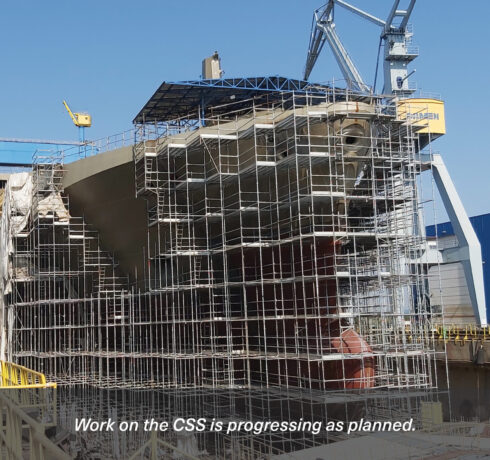Plenty of progress has been made recently on Damen Naval projects. Read here for the main updates on the F126 frigates for the German Navy, the Midlife Update/Appointed Maintenance of HNLMS Johan de Witt, the autonomous sailing project F.A.S.T. and the Combat Support Ship (CSS) Den Helder.
F126: two major contracts secured
September saw the F126 project sign contracts with two further German suppliers: Rolls-Royce and MAN Energy Solutions. Both companies will be delivering key elements of the combined diesel-electric-and-diesel (CODLAD) propulsion system that will be installed on the F126 frigates.
Rolls-Royce will be supplying 16 of its mtu Series 4000 diesel generator sets: four for each of the F126 frigates. These gensets are notable in that they are capable of operating at variable speeds, thus facilitating more efficient operations: saving fuel and reducing maintenance. Furthermore, because the gensets will be equipped with mtu selective catalytic reduction systems, providing compliance to IMO Tier III emissions regulations.
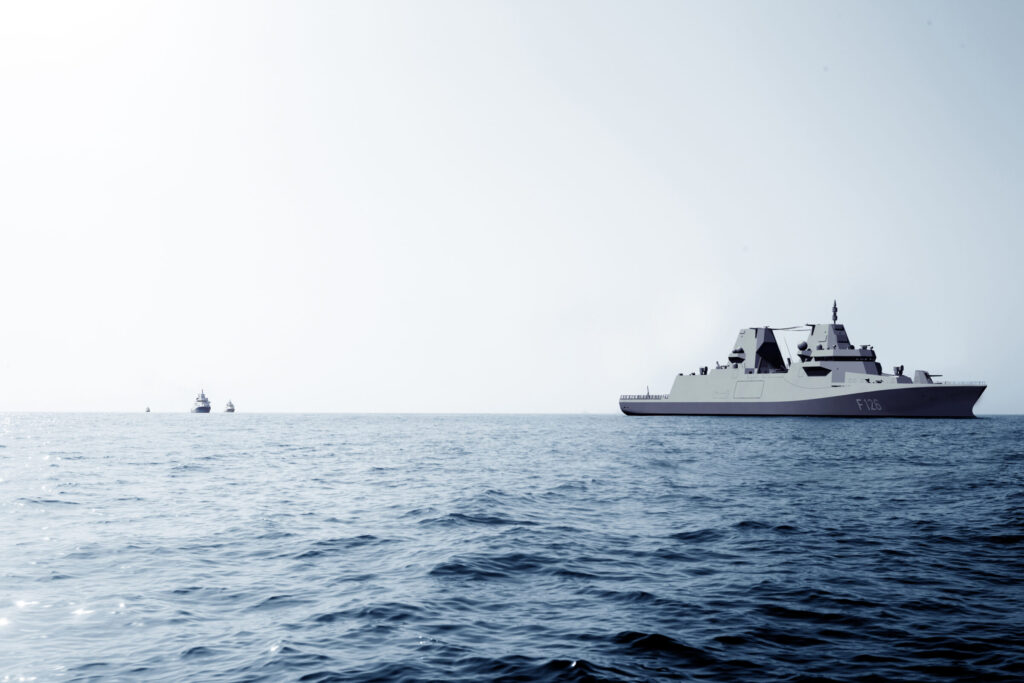 Contracts have been signed with two German subcontractors for the F126 project.
Contracts have been signed with two German subcontractors for the F126 project.
The contract is also significant because it marks the first time that Damen Naval is combining variable speed generator sets with an onboard DC Grid on a naval vessel. This is the second major contract secured with Rolls-Royce for the F126 project; earlier this year Damen Naval announced its selection of Rolls-Royce to supply the automation solutions (mtu NautIQ Master and mtu NautIQ Foresight) for the F126 frigates.
The propulsion systems of the F126 frigates that Damen Naval is building for the German Navy took a further step forward with the agreement signed with MAN Energy Systems. MAN will be supplying eight of its 32/44CR propulsion engines, once again two for each of the four frigates. In addition to IMO Tier III compliance, these engines will be installed with a high-displacement, soft-resilient mounting system to comply with the latest regulations regarding shock and noise requirements.
“These are key contracts for the F126 project, demonstrating that this project is progressing nicely,” says Frank Verhelst, Damen Naval’s F126 Project Director. “We are looking forward to receiving the first deliveries from Rolls-Royce and MAN early in 2024.”
Project F.A.S.T. has a deadline and may get a sequel
By April 2023, Project F.A.S.T. must be silent, emissions-free and autonomous. That is the goal for Project Leader Jochem Nonhebel and at the moment everything is on track to meet that deadline. “We are currently preparing for the refurbishment this winter. In November, the boat will be taken out of the water again and the new electric motors will be installed. It’s still a little tense whether we can get the batteries delivered on time, but if everything goes according to plan, it should work out.”
Every opportunity is taken to collect data; data that is used by project partner Captain AI, among others, for software development. For instance, the Scheldebeker took place on 21 August; a swimming event in which participants swim from Vlissingen to Breskens. “We were asked operate as an escort boat, sailing alongside the swimmers during their crossing,” says Jochem. “It was a day with a lot of wind and high waves and it was very interesting for us to be there. It is forbidden to swim in the harbour where we normally sail, but it happens anyway. By participating in this event, we were able to collect a lot of important data on swimmers.”
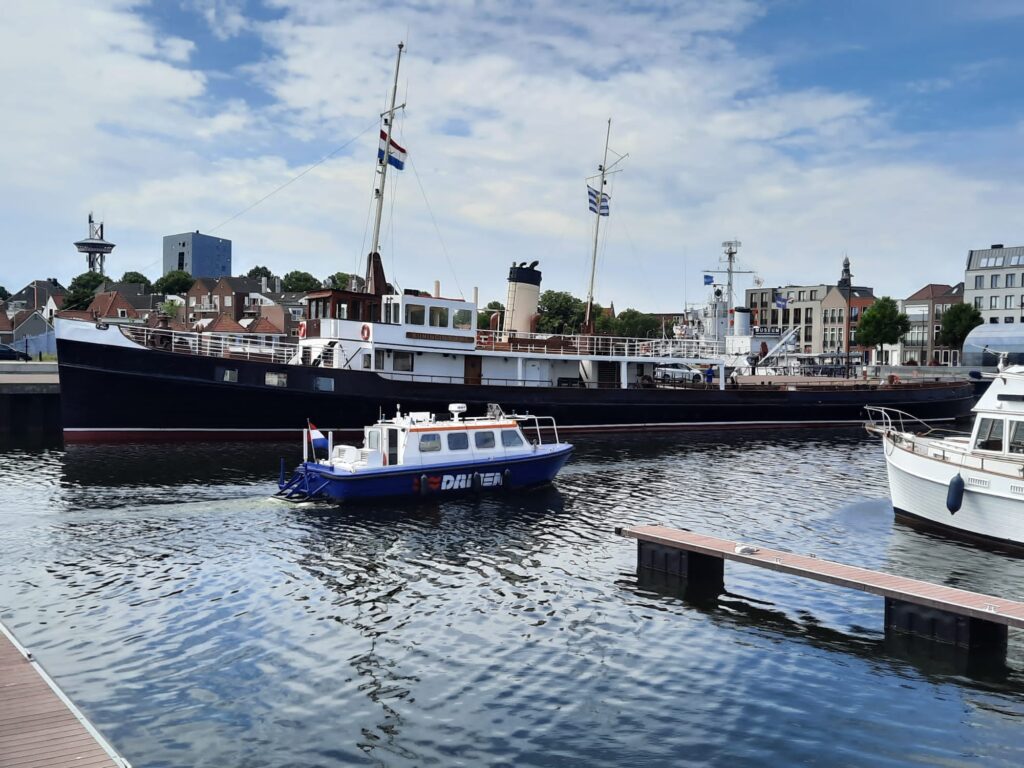 Project F.A.S.T. is making use of every opportunity to gather data.
Project F.A.S.T. is making use of every opportunity to gather data.
The project team of Jochem, Karine Jansen, Marcel van der Heide and Pieter de Korte was recently expanded to include a new intern, Robin Janse, who will work on the onboard cooling systems. “The new electric motors and batteries need to be cooled and that requires a fairly complex system which he will design under supervision,” Jochem explains. Another intern Wesley de Leeuw is working at Praxis Automation in Leiderdorp to design and fine-tune the electric motor system.
As plans for the F.A.S.T. boat continue, Jochem says it is starting to look like the project will be continued. “We have been approached by Baltic Workboats Estonia to jointly lead a project with a semi-unmanned vessel. It is a serious, large project in which we will design and build a new ship with a sizeable group of international partners, equipped for military missions in different domains: under, on and above water. The fundamental knowledge that we have built up within F.A.S.T. will be applied and improved one-to-one here.” The project is due to start in 2024 and a grant will be applied for from the European Defence Fund (EDF) at the end of this year.
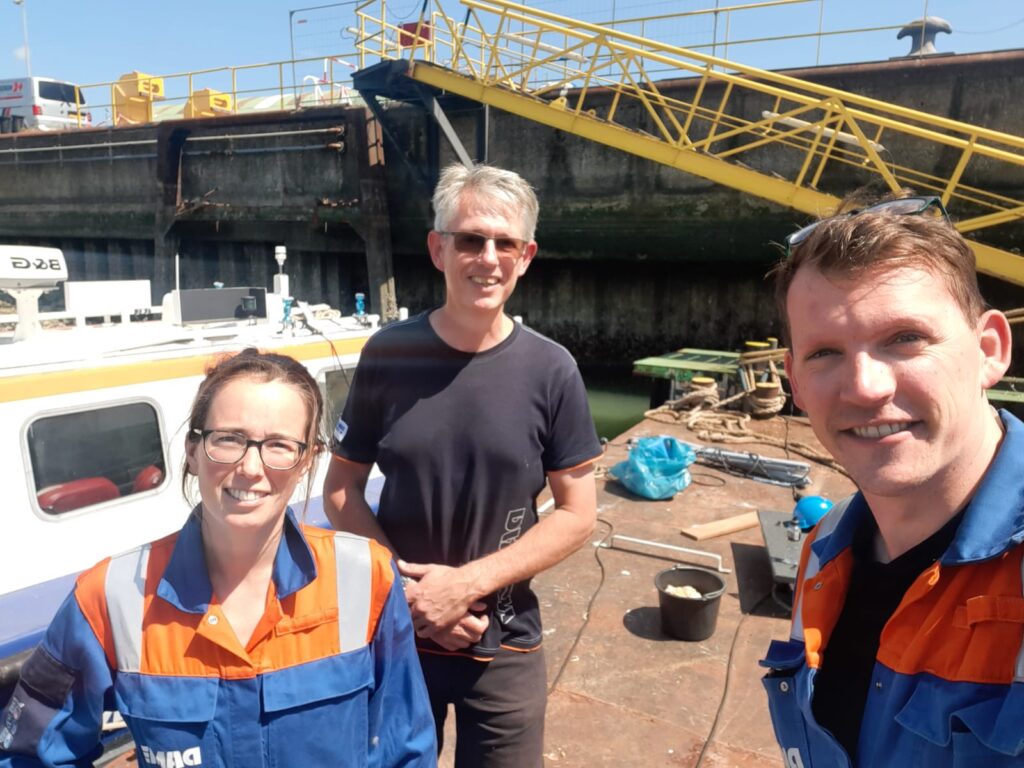 Karine Jansen, Marcel van der Heide and Pieter de Korte are all members of the project team.
Karine Jansen, Marcel van der Heide and Pieter de Korte are all members of the project team.
“This was always our idea: we wanted to create a platform with the F.A.S.T. vessel and invite industry stakeholders to develop the idea together further,” Jochem said. “Innovation managers from the Dutch Navy have already been on board twice and Thales wants to use our boat to test a new radar. There is an open invitation for providers: come on board and show what you can do. That is the aim of this project: to stimulate research into autonomous sailing.”
Possible extra work for HNLMS Johan de Witt MLU
The Vlissingen-Oost shipyard is working hard to ensure that HNLMS Johan de Witt can leave Dock 2 on time. The ship is now in Damen Shiprepair Vlissingen’s (DSV) covered dock for the dry-docking scope of the Midlife Update (MLU) and Appointed Maintenance. The dock is needed from December for other projects, but according to Project Director Fer Tummers, that deadline is achievable. “The staffing in and around the ship has increased significantly recently. We are currently working with at least 400 people on the project and at this rate we are going to manage to get the ship back at the quayside in early December. A large group of subcontractors and temporary staff have also been working during the summer shutdown.”
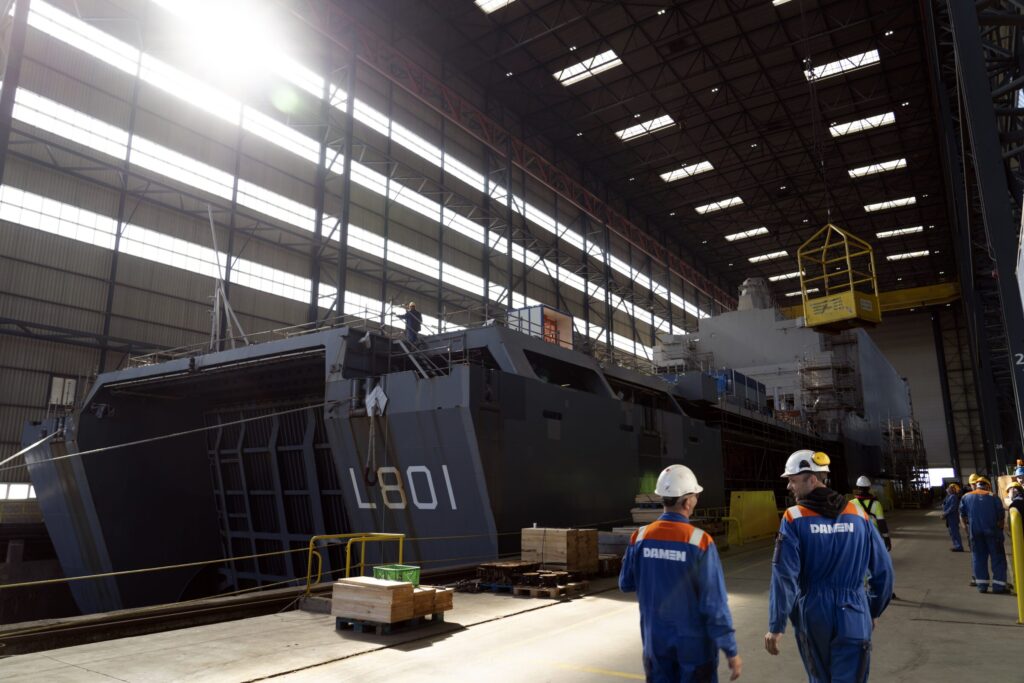 Nearly 400 people are currently working on the Midlife Update and Appointed Maintenance for HNLMS Johan de Witt.
Nearly 400 people are currently working on the Midlife Update and Appointed Maintenance for HNLMS Johan de Witt.
Cooperation with DSV and the Defence Materiel Organisation (DMO) and the Naval Maintenance and Sustainment Agency (DMI) is going well, Fer says. “DMO and DMI are currently thinking about moving some of the work they initially planned to do themselves in Den Helder to Vlissingen and possibly (partly) have it done by us. We are now in talks about that, but it would be nice for the project if we could bring that work to Vlissingen.”
Employees on the project continue to be tested twice every week for COVID, and that testing policy is having an effect. Fer: “We do about 800 to 1,000 tests a week and we see peaks and troughs. We still pick out people every week who test positive but have no symptoms. So the testing does make sense.”
Despite the challenges, it is still a lot of fun, Fer says. “It is a complex project. We have to do a lot of work in a relatively short time. I think it will total about 500,000 man-hours over 13 months. In addition, rebuilding an existing ship is completely different from building a new ship. It requires a lot of thought and fine-tuning. It is a different complexity than new construction and I really like that.”
CSS: water levels, propeller shafts and buoyancy aids
In Romania, the Danube is being closely monitored. The water level is so low that it is potentially going to affect the floating of the Combat Support Ship, which is needed to move the ship from the dry part of the dock to the wet part. “Although the ship is not going up the Danube, the water at the riverside has to be high enough to position the dock door. This is because this door has to be floated into position and there is currently insufficient water for this,” explains Project Director Arjan Risseeuw. “The floating is planned for mid-October, and we hope that the water level will have risen enough before then, but it is a bit touch-and-go.”
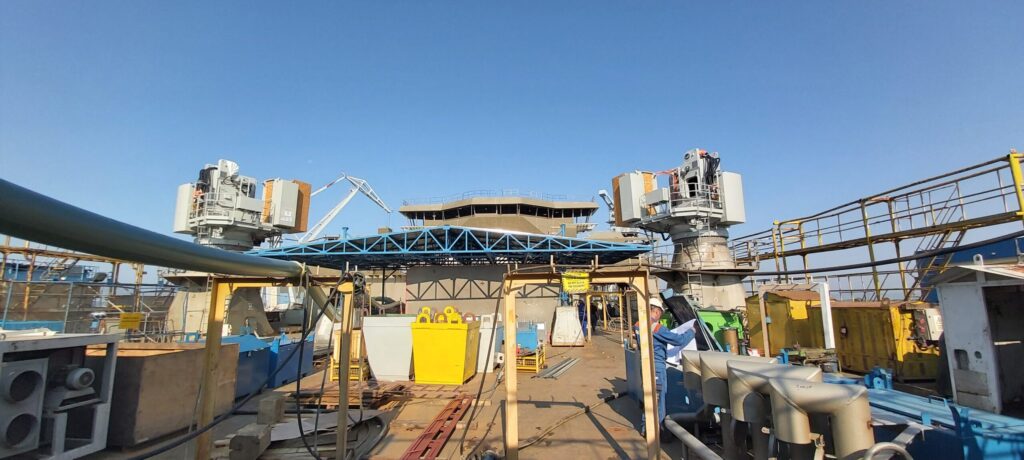 The forward part of the superstructure has been placed, as well as the two Palfinger cranes on the foreship.
The forward part of the superstructure has been placed, as well as the two Palfinger cranes on the foreship.
painted and the outboard propeller shafts are currently being installed. On the quayside, construction of the various modules that will be placed on the vessel after October is still underway. “This will involve the superstructure. The first part, the forward part with the ship’s bridge, has already been placed, but the rest will follow when the ship is in the water. On the foreship, the two Palfinger cranes are now also in place.”
Elsewhere in the yard, work has started on the construction of the steel frame that will be used as the buoyancy aid to facilitate equal draft of the fore and aft. This is required to move the ship safely to the deep part of the dock. Air bags will soon be placed in the frame to help float the ship. “We recently had the risk analysis for the floating operations and, for now, everything is on track for successful implementation,” concludes Arjan. “Before then, however, we do hope that the water level in the Danube will rise again.”
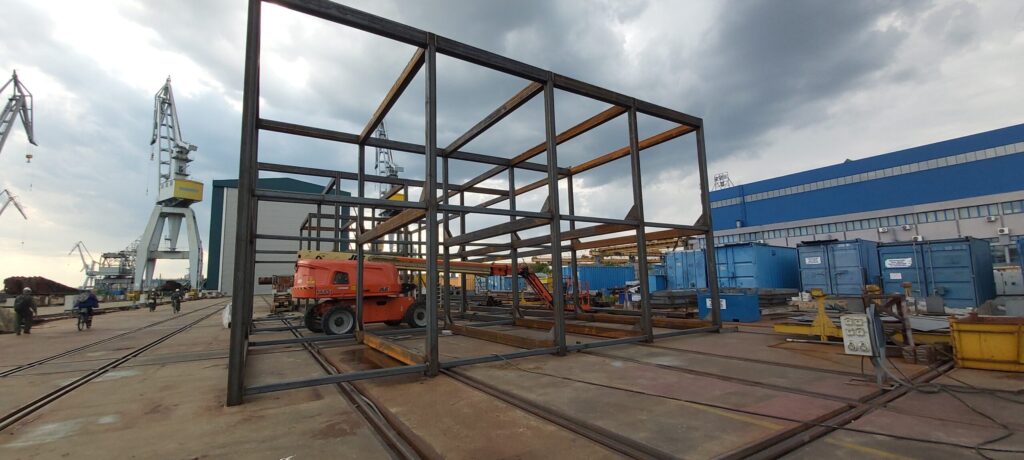 The steel frame for the buoyancy aid.
The steel frame for the buoyancy aid.

